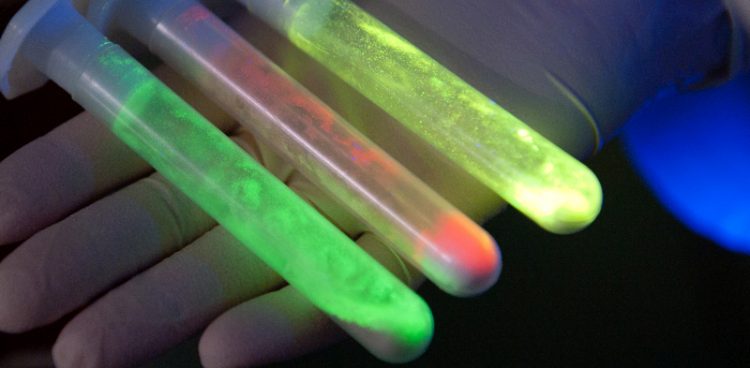Second Place in EARTO Innovation Award 2015 competition for Fraunhofer ISC

Fluorescent nanoparticles Source: Dobberke for Fraunhofer ISC
In 2009, 8 million people i.e.1 percent of the European population had chronic wound issues that needed care, consuming 2 percent of the European health budget. With an increasingly older population, the treatment of chronic wounds will become an even greater challenge to healthcare systems in Europe.
Therefore, affordable innovative diagnosis and treatment tools are essential. Within the SkinHeal project an interdisciplinary team of 5 Fraunhofer Institutes came up with 4 innovations for the therapy of chronic skin diseases.
A central subject was the development of a unique in-vitro model for chronic wounds, particularly for diabetic wound milieus. This model can be used for the evaluation of new wound dressing concepts. For the standardized wounding of the artificial skin tissue an automated cutting device was developed, too. Second was the adaptation of microfluidic actuators and sensors into the wound dressing.
These allow to applicate local vacuum assisted therapies and to extract the wound exudate without having to change the dressing. Characteristic biomarkers taken from the exudate help monitor the wound healing process.
The third innovation is the insertion of immunotoxic or other active agents into the wound dressing. A controlled drug release supports the healing process. So the effect of the active agents can quickly be verified. The fourth innovation enables the monitoring of real chronic wounds by fluorescent nanoparticles. They specifically bind to the wound biomarkers and enable a future home care diagnostic via smartphone technology.
The treatment of chronic wounds costs around eight billion euros each year in Germany only. A modern wound management can reduce these costs up to 50 percent and improve life quality of the afflicted person. In-vitro models simulating diseases can significantly reduce expensive parallel developments of materials as well as active agent candidates.
They also offer a more reliable alternative to animal testing. Out-patient monitoring of the healing process could become possible with easy-to-handle diagnostic tools, for example via smartphone at home. This means substantial cost savings by shorter in-patient hospital stays.
More information about EARTO Innovation AWARD 2015: http://www.isc.fraunhofer.de/fileadmin/FILES/download/news/EARTO_Innovation_Awar…
Contact:
Marie-Luise Righi
Leiterin Marketing und Kommunikation
Phone: +49 931 4100-150
Email: marie-luise.righi@isc.fraunhofer.de
Media Contact
Alle Nachrichten aus der Kategorie: Förderungen Preise
Neueste Beiträge

Lebensretter unter der Haut
Erstmals in der UMG Defibrillator mit Brustbein-Elektrode gegen den plötzlichen Herztod implantiert. Im Herzzentrum der Universitätsmedizin Göttingen (UMG) wurde einem Patienten mit Herzrhythmusstörungen erstmals ein neuartiger Defibrillator mit Brustbein-Elektrode implantiert:…

Studie zeigt Zunahme der UV-Strahlung in Mitteleuropa
Langzeitanalyse zu Daten aus dem deutschen UV-Messnetz erschienen: Ausgabejahr 2024 Datum 28.11.2024 In den vergangenen Jahrzehnten hat sich die UV–Strahlung in Teilen von Mitteleuropa unerwartet stark erhöht. Zwischen 1997 und…

Stundenlanges Fräsen von Umformwerkzeugen passé
Die Großserienfertigung von Bipolarplatten für Brennstoffzellen erfolgt im Sekundentakt. Um eingesetzte Umformwerkzeuge vor Verschleiß zu schützen, werden sie aus hochwertigen Metalllegierungen gefräst. Im Nationalen Aktionsplan Brennstoffzellen-Produktion (H2GO) geht das Fraunhofer-Institut…



